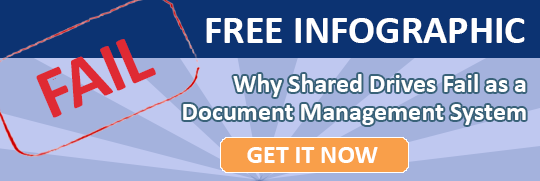CLICK HERE TO CHECK OUT OUR 2018 UPDATE ON THIS TOPIC!
As digital technology has permeated all areas of business, many organizations have made the transition from paper document management to an electronic system. Most commonly, they manage documents via a shared company drive which contains all necessary records and documents needed for the business to operate. While shared drives offer a number of advantages over paper-based systems, they still have significant downfalls. Below are some of the most common problems with shared drives being used to manage documents.
Simple Indexing
One of the foremost shared drive problems is that they have very limited indexing capabilities. In fact, indexing is very similar to the indexing of paper files. There is limited ability to cross reference, you cannot add metadata to files, and tagging is limited – all of these factors mean that while shared drives have better searchability than paper systems, they are still far inferior to more sophisticated systems.
Limited Security
One of the biggest problems with shared drives is that they have limited security capabilities. While you are able to limit access to certain folders or files, there is very little functionality beyond this. In particular, shared drives don’t allow users to secure documents easily at a granular level, meaning security and access permissions are clumsy and inefficient.
Lost or Misplaced Files
Another reason that shared drives are a poor way to manage documents is that within them, files can be very easily misplaced. If a user accidentally deletes a file, moves it into another folder, or saves over it using a different name, the process of retrieving the document – if it’s even possible – can be time-intensive. Considering that the average lost file costs a company $120, this is a significant risk.
Duplicate Records
Document control is a very common problem with shared drives being used to manage documents. In particular, version control becomes a issue, and the result is that duplicate or redundant business records and documents exist in droves. This is more serious than just being an impediment on time and productivity – a lack of version control is a risk because employees could unknowingly use the wrong version of a document to make a decision or external interaction, which can have damaging effects.
Out of Office Access
One of the most significant shared drive issues is that they provide zero remote access for employees working from home or traveling for business. Many SMBs simply do not have the infrastructure in place for secure and fast remote access. With mobile workforces becoming more popular (and necessary), this is a serious limitation.
While shared drives do offer many advantages over paper-based systems, they are still not a very effective way to manage documents. In particular, they lack some of the base functionalities provided by more sophisticated systems that serve to ensure efficient and comprehensive document management solutions.
To learn even more about how your business is being harmed by the shared drive issues associated with using it being used to manage your documents, download our free infographic below and share it with your office.

